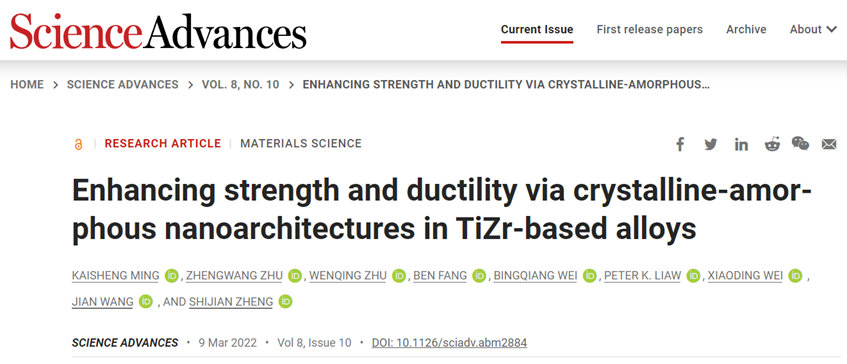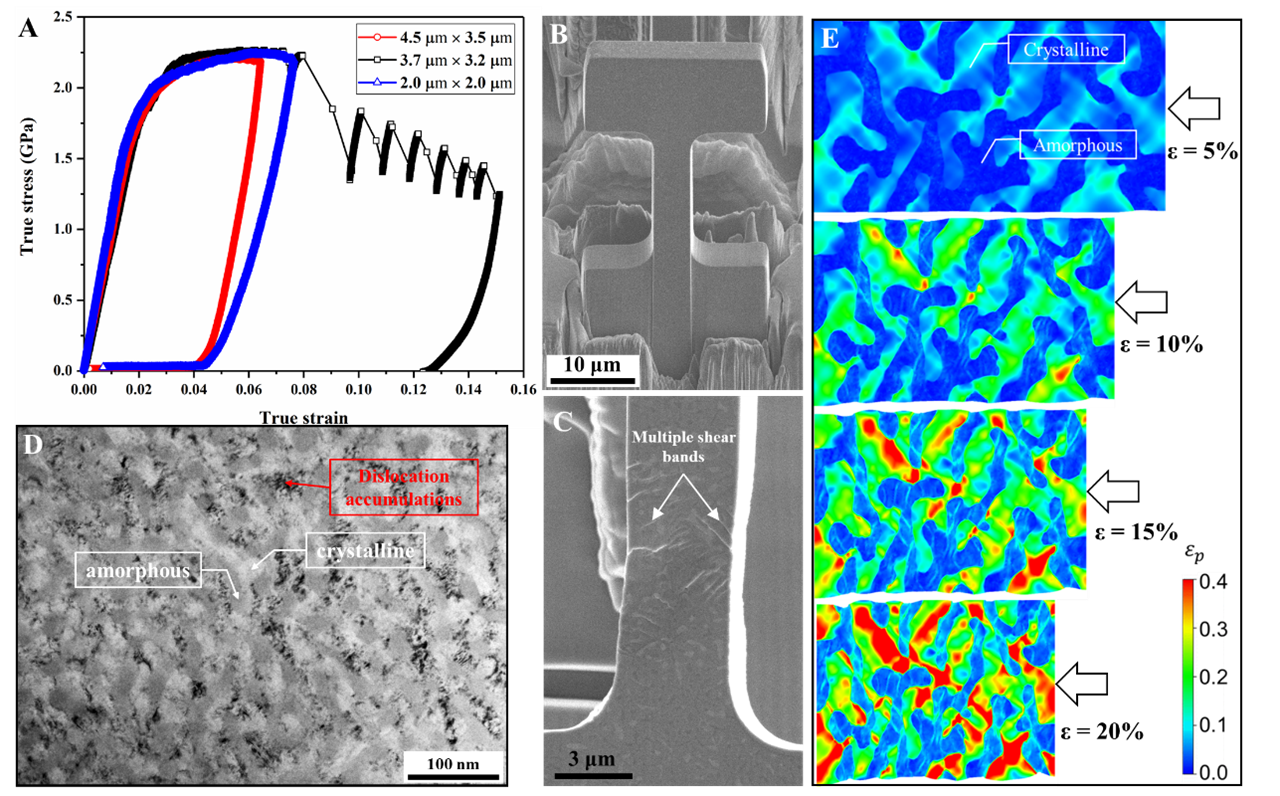Recently the Atomic Scale Research Group of Hebei University of Technology designed a three-dimensional bicontinuous crystalline-amorphous nanoarchitecture (3D-BCAN) in TiZr-based alloys, achieving enhanced strength and ductility. This work has been published in Science Advances, entitled “Enhancing strength and ductility via crystalline-amorphous nanoarchitectures in TiZr-based alloys”. The first authors are Associated Prof. Kaisheng Ming and Prof. Zhengwang Zhu, and the corresponding authors are Prof. Shijian Zheng (Hebei University of Technology), Prof. Xiaoding Wei (Peking University), and Prof. Jian Wang (University of Nebraska-Lincoln). This work offers a strategy for producing strong and ductile crystalline-amorphous composite through 3D nano-architecting design.

Strength and ductility are arguably two important mechanical properties of structural materials, while they are mutually exclusive in general, referred to as the strength-ductility trade-off. Crystalline materials can be strengthened through refining grains and/or introducing secondary phases, because the interfaces, such as grain boundaries (GBs) and phase boundaries, impede the motion of dislocations. However, the ductility is generally reduced due to the sacrifice of the strain-hardening capability. Metallic glasses display much higher strength than that of their crystalline counterparts, but have a very low plastic strain (< 2%) before catastrophic brittle fracture, due to the shear-band softening effect. The metallic-glass matrix composites (MGMCs), composed of microscale crystalline dendrites distributed in a continuous amorphous matrix, can reconcile the strength and ductility. However, most conventional MGMCs have no strain-hardening capabilities under tension, and thus, their strength cannot reach that of bulk-metallic-glasses counterparts as a result of soft crystalline phases or shear-band softening effect in amorphous phases.

In this work, the authors design and synthesize novel TiZr-based nanoscale crystalline-amorphous composites (nano-CACs) by melt-spinning with extremely-high rates of cooling. As shown in Fig. 1, the TiZr-based nano-CAC consists of micro-sized equiaxed grains with nano-width amorphous GBs. Most importantly, each micro-grain comprises nano-sized metastable crystalline phases and amorphous phases that are arranged in the form of 3D-networked nano-bands, which are referred to as 3D bicontinuous crystalline-amorphous nanoarchitectures (3D-BCANs). As shown in Fig. 2, in situ tension tests reveal that the 3D-BCANs impart ultra-high yield strength (~1.80 GPa), ultimate tensile strength (~2.3 GPa), and large uniform ductility (~7.0%) into the TiZr-based alloy. The metastable crystalline phase plastically deforms through dislocation slip and martensitic phase transformation, while the nano-sized amorphous phases exhibit homogeneous flow behavior due to interface constraints. Experiments combined with finite element simulations reveal the synergetic deformation mechanisms; i.e., the amorphous phase imposes extra strain hardening to crystalline domains while crystalline domains prevent the premature shear localization in the amorphous phases. Compared with both individual constituent crystalline and amorphous phases, an exceptional strength-ductility-strain hardening combination is realized due to the co-deformation mechanism associated with the 3D-BCANs coupled with transformation-induced plasticity. These mechanisms endow the material with an effective strength–ductility–strain hardening combination.

Fig. 2. Tensile behaviors of the TiZr-based nano-CACs consisting of 3D-BCAN micrograins and continuum modeling results for nano-CAC under compression.
For further information, please see links below:
https://www.science.org/doi/full/10.1126/sciadv.abm2884?af="R
Kaisheng Ming#; Zhengwang Zhu#, Wenqing Zhu, Ben Fang, Bingqiang Wei, Peter K. Liaw, Xiaoding Wei*, Jian Wang*, Shijian Zheng*; Enhancing strength and ductility via crystalline-amorphous nanoarchitectures in TiZr-based alloys, Science Advances , 2022, 8 (10): eabm2884.
DOI: 10.1126/sciadv.abm2884